Flora of Uttarakhand
Uttarakhand comprises of 13 districts spreading over an area of 51,082 sq km, floristically,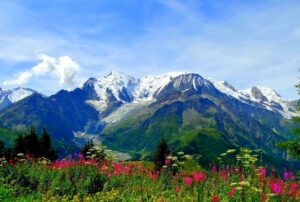 it falls under the west Himalayan Biogeography zone and it is well-known for floral diversity similar to any other Himalayan region in the country with an estimated 4,000 species of flowering plants having great economic medicinal, aromatic and artistic value. The endemic plant wealth of Uttarakhand is worth mentioning as it ultimately forms part of the National heritage. Uttarakhand Himalayas have about 116 species asindigenous group. Are naria ferruginea; Chimonobambusa jaunsarensis, Gentian tetrasepala, G. saginoides, Meeboldia solenoids, Microschoenus duthiei, Trachycarpus takil, Poa rhadina, etc are some such species.
it falls under the west Himalayan Biogeography zone and it is well-known for floral diversity similar to any other Himalayan region in the country with an estimated 4,000 species of flowering plants having great economic medicinal, aromatic and artistic value. The endemic plant wealth of Uttarakhand is worth mentioning as it ultimately forms part of the National heritage. Uttarakhand Himalayas have about 116 species asindigenous group. Are naria ferruginea; Chimonobambusa jaunsarensis, Gentian tetrasepala, G. saginoides, Meeboldia solenoids, Microschoenus duthiei, Trachycarpus takil, Poa rhadina, etc are some such species.
Besides, many plant species new to science have been added from different parts of Uttarakhand. Some such species are Anemone raui, Arenaria curvifolia, Carex nandadviensis, List era nandadeviensis, Saussurea sudhanshui, Euphorbia sharmae, Androsace garhwalicum, etc. More interesting to note is the presence of one of the smallest flowering plants Arceuthobium minutissimum, parasitising over Pinus gerardiana (Chilgoza) and the tallest plant of Asia, the Pinus roxburghii, in Uttarkashi district. The sacred Mulberry, Morus serrata, said to have been planted by the Adi Shankaracharya at Joshimath, the tree fern Cyathea spinulosa, the gigantic Aesculus indica on way to Panwali, the tall Shore a Robusta (Raja Sal) near Byasi are some other curiosities of the area. The narrative of the plant wealth of Uttaranchal will not be complete unless a mentioned about the sacred plants commonly used in worship in “The Abode of Gods”. Besides, the earlier mentioned “Brahmakamal”, Zanthoxylum armatum (Timur), Prunus puddum (Panya), Skimmia laureola, Primula denticulata, and Artemisia nilagirica, Eagle marvelous etc. are offered to deities. Some other representative and interesting plants of Uttaranchal are enumerated below with a brief description:
The vegetation of Uttarakhand can be divided in the following zones:
1. Sub-Tropical Zone of Uttarakhand
The sub-tropical zone has pure as well as mixed forests of Shore Robusta (SaI), the others being Lannea coromandelica (Jhingan), Buchanania lanzan, Dalbergia disso (Shisham), Haldina cordifolia (Haldu), Syzygium cumini (Jamun), Mallotus philippinensis (Rohini), Mitragyna parvifolia, Terminalia spp. (Myrobalans), Ficus spp. (Figs), Macaranga pustulata, Callicarpa arborea, Diopoknema butyracea (Chyura), Bauhinia variegate (Kachnar), Bomb ax cobia (Semal), Lydia claying (Pula), Schleicher oleos (Kokum), Holoptelea integrities (Karanj), Cassia fistula (Amaltas), Nyctanthes arbor-tristis (Parijat), Anogeissus latifolia (Bakli, Dhaura), etc. The shrubby vegetation is represented by Murraya koenigii, Carissa opaca, Clerodendrum viscous, Adhatoda vasica, Jasminum multiflorum, Solanum erianthum, Cal/icarpa macrophylla, Eranthemum nervosum, Phlogacanthus thyrsiformis, Jatropha curcas, Rhus parviflora, Dodonaea viscosa, Woodfordia fruticosa and many others.
2. Temperate Zone of Uttarakhand
The Temperate zone is marked by the presence of Quercus leucotrichophora (Banj oak), Rhododendron arboretum (Burans), Myrica esculent a (Kaphal), Leonia ovalifolia (Aynor), Ibex dipyrena, Quercus semecarpifolia (Kharsu Oak), Q. dilatata (Moru Oak), etc. The coniferous forests in this zone are unique. Pure stands of Pinus roxburghii (Chir Pine) and Cadres deodar (Deodar, Cedar), Abides windrow (Raga), Pinus wal/ichiana (Kail), Taxus wal/ichiana (Thuner, Himalayan Yew) at places give a pristine look to the slopes. The slopes in temperate zone also have insectivorous plants like Drosera peltata and species of Utricularia. Another such species is Pinguicula alpina seen in Martoli Bugyal, Kumaon. The Saprophytes and Parasites are also well represented by Monotropa unit/ora, Dendrophthoe falcata (Banda), Balanophora in volucrata, and species of Viscum, Korthalsella, Arceuthobium, Scurrula, etc. The zone has a variety of useful plants, some of them well known for centuries. These include Cedrus deodar a, Pinus spp., Abies pindrow, Quercus spp., Aconitum heterophyllum, Paeonia emodi, Swertia chirayita, Bergenia ciliata, Dioscorea deltoidea, Angelica glauca (Choru), etc.
3. Sub-Alpine and Alpine Zones of Uttarakhand
The altitude above 3,000 metres is generally considered a zone of sub-alpine and alpine vegetation. The tree species are represented by Pinus wallichiana, Abies pindrow, Prunus cornuta, Acer caesium, Betula utilis (Bhoj Patra) and Salix sp. Species of the genera Cotoneaster, Rosa, Berberis, Ribes, Junipers, Rhododendron anthropogenic, Rhododendron campanulas are the shrubby components of the zone. The herbaceous vegetation is represented by a number of species of genera Po ten till, Primula, Aster, Saxifrage, Achaean, Delphinium, Polygonal, Corydalis, Pleurospermum, Meconopsis, Pedicularis, Saussurea, Rheum, Silene, etc. The Bugyals of this zone are well known for a rich and diversified flora. Plant species like Nardostachys grand flora (Jatamansi), Podophyllum hexandrum (Himalayan May-Apple, Papri), Picrorhiza kurrooa (Kutaki), Gentian burro, Armenia benthonic (Bal char), Rheum moorcroftianum (Dole), Ephedra gerardiana, Dactylorhiza hatagirea (Hatthajari), etc., common in this zone, are of immense medicinal value.
The floral diversity is further exhibited by the species that grow in the rain shadow areas of Uttaranchal. Such species develop adaptive characters to survive the wrath of adverse climate. Labium rhomboid, Thylacospermum caespitosum, Acantholimon Iycopodioides, Dracocephalum heterophyllum etc.
Popular Trees in Uttarakhand
Popular Name: Kachnaar or Orchid Tree
Botanical Name: Bauhinia Variegata
Altitude (Meters): 600-900
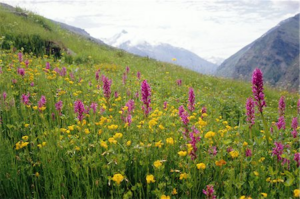 Uttarakhand has more than 225 species of this charming group, well known for ornamental flowers with great horticultural potential and long shelf life. Aerides, Coelogyne, Cymbidium, Dendrobium, Thunia and Rhynchostylis, for which Mandai, Baram, Shandev, Dafia Dhoora, Kaflani, etc are rich. Among the global orchids, species of Calanthe, Habenaria, Anoectochilus, Satyrium, etc are fairly common while`the Lady`s Slipper Orchid-Cypripedium is scarcely distributed.
Uttarakhand has more than 225 species of this charming group, well known for ornamental flowers with great horticultural potential and long shelf life. Aerides, Coelogyne, Cymbidium, Dendrobium, Thunia and Rhynchostylis, for which Mandai, Baram, Shandev, Dafia Dhoora, Kaflani, etc are rich. Among the global orchids, species of Calanthe, Habenaria, Anoectochilus, Satyrium, etc are fairly common while`the Lady`s Slipper Orchid-Cypripedium is scarcely distributed.
Many small river valleys offer wonderful experience to nature lovers and hikers. The vast open hay field, above the tree line present endless views of the variously coloured Himalayan flowers. The most interesting of them, aesthetically or botanically are seen in the higher altitudes, from 2,450 metres and above. The arrival of spring brings forward an uprising of colours, when the Semal and Palash put the lower altitude forests on fire with their blazing red flowers. It is also the time for Burans to spread its fire at a height of or above 2,450 metres adding colour to the blue and white panorama of snow. The flowers do not grow only in the Valley of Flowers but are found on different treks habitually upto great heights as also on the hay field and even in rock cracks or moraines.
It is a small to medium-sized tree growing to 10-12 m tall, deciduous in the dry season. The leaves are 10-20 cm long and broad, rounded, and bilobed at the base and apex. The flowers are conspicuous, bright pink or white, 8-12 cm diameter, with five petals. The fruit is a pod 15-30 cm long, containing several seeds.
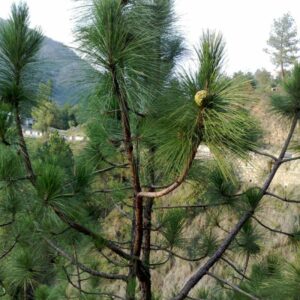 Popular Name: Chir or Pine Tree or 3 Needle Pine
Popular Name: Chir or Pine Tree or 3 Needle Pine
Botanical Name: Pinus Roxburghii
Altitude (Meters): 600-900
Chir (Pine) is a large evergreen tree. The tree crown is elongated and more or less pyramidal upto middle age but later becomes spreading, rounded or umbrella-shaped with a massive branch system. Under favourable conditions, it attains large dimensions and forms a straight cylindrical bole. Trees up to 55 m in height and 3.5 m in girth have been recorded in favourable localities.
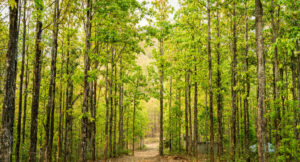 Popular Name: Sal Tree
Popular Name: Sal Tree
Botanical Name: Shorea Robusta
Altitude (Meters):600-750
Sal is moderate to slow growing, and can attain heights of 30 to 35 m and a trunk diameter of up to 2-2.5 m. The leaves are 10-25 cm long and 5-15 cm broad. In wetter areas, it is evergreen; in drier areas, it is dry-season deciduous, shedding most of the leaves in between February to April, leafing out again in April and May.
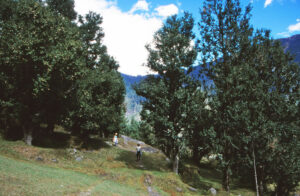 Popular Name: Oak Tree
Popular Name: Oak Tree
Botanical Name :Quercus Incana
Altitude (Meters):1700-2000
Oaks have spirally arranged leaves, with a lobed margin in many species; some have serrated leaves or entire leaves with a smooth margin. The flowers are catkins, produced in spring. The fruit is a nut called an acorn, borne in a cup-like structure known as a cupule; each acorn contains one seed (rarely two or three) and takes 6-18 months to mature, depending on species.
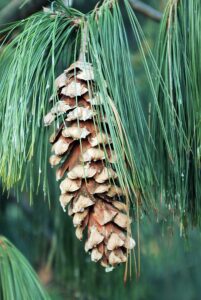 Popular Name: Blue Pine or 5 Needle Pine or HImalayan White Pine
Popular Name: Blue Pine or 5 Needle Pine or HImalayan White Pine
Botanical Name :Pinus Wallichiana
Altitude (Meters):1800-2400
The leaves (“needles”) are in fascicles (bundles) of five and are 12-18 cm long, and often droop gracefully. The cones are long and slender, 16-32 cm, yellow-buff when mature, with thin scales; the seeds are 5-6 mm long with a 20-30 mm wing.
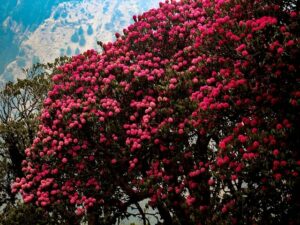 Popular Name: Buransh or Tree Rose
Popular Name: Buransh or Tree Rose
Botanical Name: Rhododendron Arboreum
Altitude (Meters): 2000-2100
Its name means ‘tending to be woody or growing in a tree-like form’. It has a height and spread up to 12m (36ft) x 12m (36ft). In early- and mid-spring, trusses of 15-20 bell-shaped flowers, 5cm (2in) wide and 3-5cm (1.25-2in) long are produced in red, pink or white. They have black nectar pouches and black spots inside.
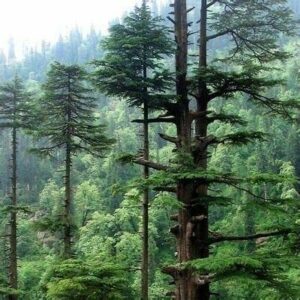 Popular Name: Deodar
Popular Name: Deodar
Botanical Name :Cedrus Deodara
Altitude (Meters): 1800-2400
It is a large evergreen coniferous tree reaching 40-50 m tall, exceptionally 60 m, with a trunk up to 3 m diameter. It has a conic crown with level branches and drooping branchlets. The leaves are needle-like, mostly 2.5-5 cm long, occasionally up to 7 cm long, slender (1 mm thick), borne singly on long shoots, and in dense clusters of 20-30 on short shoots; they vary from bright green to glaucous blue-green in colour.
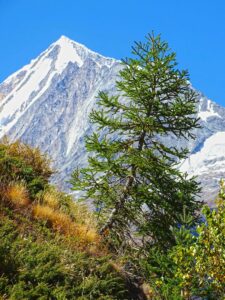 Popular Name: Himalayan Fir-Low level
Popular Name: Himalayan Fir-Low level
Botanical Name :Abies Pindrow
Altitude (Meters): 2100-2900
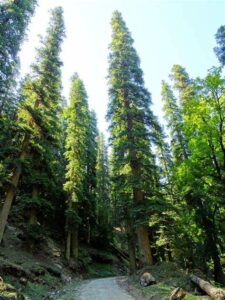 Popular Name: Himalayan Fir-High Level
Popular Name: Himalayan Fir-High Level
Botanical Name :Abies Spectabilis
Altitude (Meters):2400-3700
It is a large evergreen tree growing to 40-60 m tall, and with a trunk diameter of up to 2-2.5 m. It has a conical crown with level branches. The leaves are needle-like, among the longest of any fir, 4-9 cm long, flattened in cross-section, glossy dark green above, with two whitish stomatal bands on the underside; they are arranged spirally on the shoots, but twisted at the base to lie in a flat plane either side of the shoot.
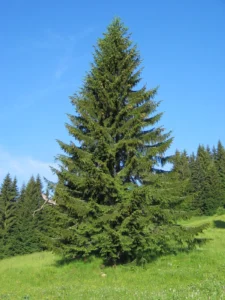 Popular Name: Spruce
Popular Name: Spruce
Botanical Name: Picea Smithiana
Altitude (Meters): 2400-2900
It is a large evergreen tree growing to 40-55 m tall (exceptionally to 60 m), and with a trunk diameter of up to 1-2 m. It has a conical crown with level branches and usually pendulous branchlets. The shoots are pale buff-brown, and glabrous (hairless). The leaves are needle-like, the longest of any spruce, 3-5 cm long, rhombic in cross-section, mid-green with inconspicuous stomatal lines. The cones are broad cylindric-conic, 9-16 cm long and 3 cm broad, green when young, maturing buff-brown and opening to 5-6 cm broad 5–7 months after pollination; the scales are stiff and smoothly rounded.
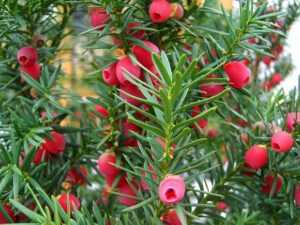 Popular Name: Yew
Popular Name: Yew
Botanical Name: Taxus Wallichiana
Altitude (Meters): 2400-2700
It is a medium-sized evergreen coniferous tree growing to 20 m tall, similar to Taxus baccata and sometimes treated as a subspecies of it. The shoots are green at first, becoming brown after three or four years. The leaves are thin, flat, slightly falcate (sickle-shaped), 1.5–2.7 cm long and 2 mm broad, with a softly mucronate apex; they are arranged spirally on the shoots but twisted at the base to appear in two horizontal ranks on all except for erect lead shoots.
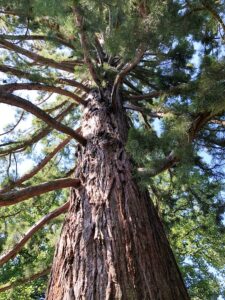 Popular Name: Cypress
Popular Name: Cypress
Botanical Name: Cupressus Torulosa
Altitude (Meters): 2300-2400
They are evergreen trees or large shrubs, growing to 5-40 m tall. The leaves are scale-like, 2-6 mm long, arranged in opposite decussate pairs, and persist for 3–5 years. On young plants up to 1–2 years old, the leaves are needle-like, 5-15 mm long. The cones are 8-40 mm long, globose or ovoid with 4-14 scales arranged in opposite decussate pairs; they are mature in 18–24 months from pollination. The seeds are small, 4-7 mm long, with two narrow wings, one along each side of the seed.
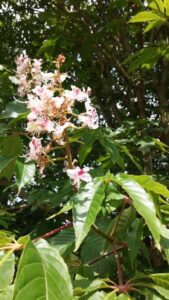
Popular Name: Horse Chestnut
Botanical Name: Aesculus Indica
Altitude (Meters): 1800-2100
Aesculus hippocastanum, the horse chestnut, soapberry and lychee, is a species of flowering plant in the family Sapindaceae. It is a large deciduous, cyanaceous tree. It is also called horse-chestnut, European horse chestnut, buckeye, and conker tree. It is also sometimes called Spanish chestnut. This name is commonly used for Castanea sativa.
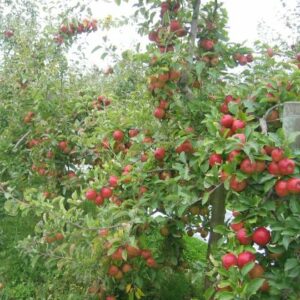 Popular Name: Strawberry Tree
Popular Name: Strawberry Tree
Botanical Name: Comus Capitata
Altitude (Meters): 2000-2300
StrawberryThe Strawberry Tree grows to 5-10 m tall, rarely up to 15 m, with a trunk diameter of up to 80 cm. The leaves are dark green and glossy, 5-10 cm long and 2-3 cm broad, with a serrated margin. The hermaphrodite flowers are white (rarely pale pink), bell-shaped, 4-6 mm diameter, produced panicles of 10-30 together in autumn. They are pollinated by bees.
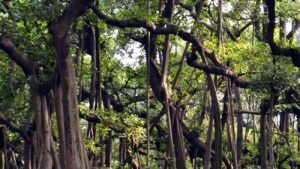 Popular Name: Bhojpatra
Popular Name: Bhojpatra
Botanical Name: Betula utilis
Altitude (Meters): up to 4,500 m
Betula utilis, the Himalayan birch, is a deciduous tree native to the western Himalayas, growing at an altitude of 4,500 m (14,800 ft). The Latin specific adjective utilis means “useful”, and refers to the many uses of different parts of the tree. The white, paper-like bark was used in ancient times to write Sanskrit texts and texts. It is still used as paper for the writing of sacred mantras, the bark is placed in amulets and worn for protection.
Oak-High Level
Shrubs in Uttarakhand
Red berries, white flowers
Under fir forests with dark green foliage with red berries
Shrub with pinkish white flowers
Shrub with pinkish flower
Shrub with creamish white flowers
Juniper used in making Gin
Shrub with white flowers
Shrub with scarlet flowers
Herbs in Uttarakhand
Geranium
Anemones
Jacobs Ladder
Potentilla
Primula
Primula
Blue-Poppy
Brahma-Kamal
Blue Flowers
Edelweiss
Polygonum
Marsh Marigold
Ladies Slipper-Orchid
Aconitum Betula Utilis
Querucus Semecarpifolia
Viburnum
Skimmia
Rhododendron campanulatum
Rhododendron lepidotum
Rhododendron hypenanthum
Juniperus communis
Spirea canescenes
Woodfordia fruticosa
Geranium wallichianum
Anemones Obtusiloba
Jacobs ladder
Potentilla atrosanguinea
Primula macrophylla
Primula rosea
Meconopsis aculeate
Saussurea obvalata
Gentians
Leontopodium himalaynum
Polygonum
Caltha Palustris
Cyperipedium cordigerum
Aconitum spp

